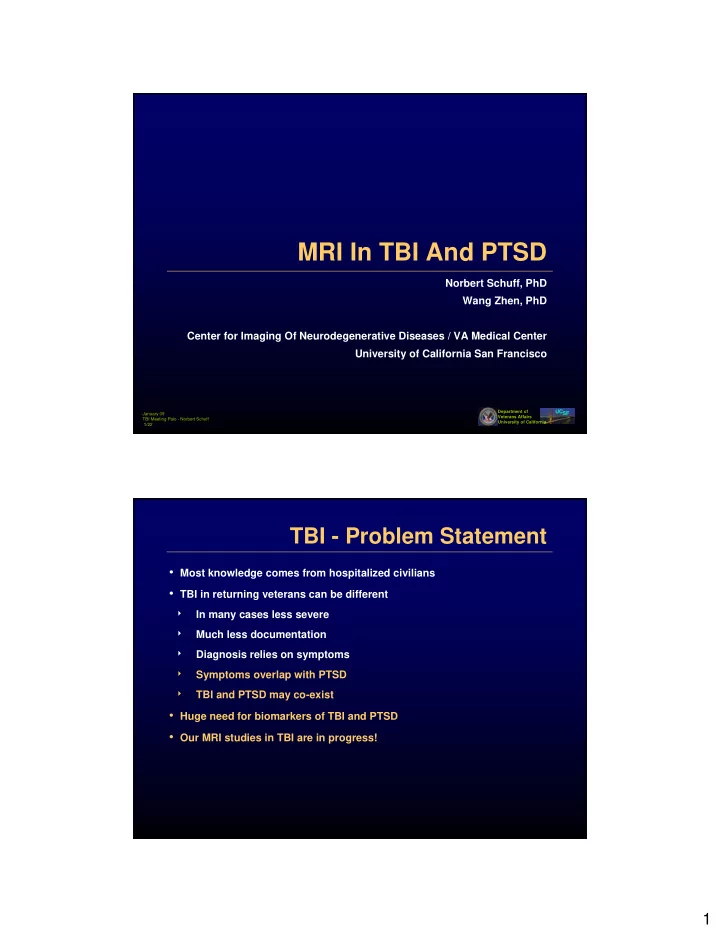

MRI In TBI And PTSD Norbert Schuff, PhD Wang Zhen, PhD Center for Imaging Of Neurodegenerative Diseases / VA Medical Center University of California San Francisco UCSF Department of January 09 Veterans Affairs TBI Meeting Palo - Norbert Schuff University of California 1/22 TBI - Problem Statement • Most knowledge comes from hospitalized civilians • TBI in returning veterans can be different ‣ In many cases less severe ‣ Much less documentation ‣ Diagnosis relies on symptoms ‣ Symptoms overlap with PTSD ‣ TBI and PTSD may co-exist • Huge need for biomarkers of TBI and PTSD • Our MRI studies in TBI are in progress! 1
Veteran TBI – Complications PTSD TBI Other Combat-Related Factors Overall Goal For MRI ‣ Objective detection of TBI and PTSD ‣ Improve differential diagnosis ‣ Predict progression ‣ Assess efficacy of therapeutic interventions ‣ Monitor treatments ‣ Elucidate mechanisms 2
MRI In PTSD: The Hippocampus • Plays an important role in ‣ Memory (declarative, spatial, and contextual) ‣ Perception of chronic pain • Susceptible to stress hormones (animal studies) ‣ Suppressed neurogenesis in the dentate gyrus ‣ Remodeling of dendrites in the CA3 region ‣ Elevated excitability of hippocampal neurons • Problems ‣ Findings of hippocampal atrophy in PTSD have been inconsistent ‣ Alterations are subtle ‣ Normal aging and many brain disorders affect the hippocampus too MRI Of Hippocampus in PTSD Structural MRI Proton MR Spectroscopy (1H MRS) PTSD Alzheimer’s Structural NAA Control PTSD C NAA r • Hippocampal atrophy in PTSD NAA Cho Cr is subtle • Reduction of N-acetylaspartate can be substantial but highly variable Schuff et al. Psychiatry Res. 2008;162(2):147-57. 3
MRI Of Hippocampal Subfields • Refine imaging of the hippocampus by resolving its subfields • Determine if PTSD impacts specific hippocampal subfields • HYPOTHESES ‣ The dentate gyrus is selectively reduced in PTSD ‣ The pattern of reduced subfields in PTSD is different from that in aging and other brain disorders, e.g. Alzheimer’s disease High-Field MRI of Subfields Histology 4 Tesla MRI 4 CA1-2 CA3&DG 5 2 3 Subiculum CA1 Resolution ERC 1 0.4 x 0.5 x 2mm 3 4
Subfield Volumes In PTSD EntorhinalCortex Subiculum CA1 CA3.DG 17 PTSD + 220 CAPS: 61 ± 14 19 Control CAPS: 8 ± 7 Volume [mm3] 170 120 70 Control PTSD Control PTSD Control PTSD Control PTSD Differential Effects Of PTSD And Age 22 34 46 58 CA1 CA3.DG PTSD Control 200 Volume [mm3] 160 120 80 22 34 46 58 Age [years] 5
Total Hippocampal Volume 5000 Volume [mm3] 4500 4000 3500 3000 Control PTSD Subfields In Other Conditions By Susanne Mueller et al. Neuroimage. 2008;42(1):42-8 AD : Alzheimer’s disease MCI: Mild cognitive impairment, a transitional condition to AD 6
Cortical Thickness In Relation To Subfields in PTSD Automated measurements of cortical thickness http://surfer.nmr.mgh.harvard.edu/ In PTSD, negative correlation between smaller hippocampus and thicker orbitofrontal cortex ASL- MRI shows hyperperfusion of orbitofrontal cortex in the same subjects Diffusion Tensor Imaging Model of fractional anisotropy 0 < FA > 1 FA Diffusivity Directionality Left-right Beaulieu, NMR Biomed. 2002;15:435–455 Up-down Front-back 7
White Matter Abnormalities In PTSD Positive correlation between FA and CA3&Dentate volume Cingulum bundle Negative correlation between FA and PTSD severity FA decrease ~ CAPS increase in PTSD+ (p<0.01) MRI in TBI • Pilot Study – findings are preliminary • All TBI are combat veterans • Comparison with veterans positive or negative for PTSD • Use of DTI • No data yet of subfields and cortical thickness in TBI FA decrease ~ CAPS increase in PTSD+ (p<0.01) 8
White Matter Alterations In TPI TBI + N = 10 all male Age: 33 ± 8 yrs DOI > 2 Years PTSD – N=14 all male Age matched CAPS: 7 ± 7 Comparison: Alterations In PTSD PTSD + N = 19 all male Age: 40 ± 12 yrs CAPS: 61 ± 13 PTSD – N=19 all male Age matched CAPS: 7 ± 7 *includes 5 not exposed to trauma 9
Challenges For MRI in TBI • Heterogeneity of brain damage ‣ Conventional group analyses may lack sensitivity ‣ Individual tests could be more effective but require a robust single subject statistics ‣ Multivariate MRI, using structural perfusion, diffusion and spectral imaging together should improve statistical power • Scale variability of damage ‣ Large versus small scale dilemma in detecting alterations ‣ Image analysis on a variable scale may be necessary FA decrease ~ CAPS increase in PTSD+ (p<0.01) Conclusions • PTSD • Reduction of dentate/CA3 in PTSD is consistent with suppressed neurogenesis under chronic stress • Dentate/CA3 reductions are not seen in normal aging, MCI and AD and therefore might be specific for PTSD • Correlations between dentate/CA3, thickness of cortical regions, and white matter degradation suggests that PTSD impacts brain networks • TBI • Findings of abnormal FA values suggest damage of motor fibers • Includes regional increase of FA – underlying mechanism unknown • Differences in DTI patterns between TBI and PTSD still inconclusive • MORE STUDIES, REPLICATING THE PRELIMINARY FINDINGS ARE • WARRANTED! 10
Impact • MRI of hippocampal subfields might ‣ yield a marker of PTSD ‣ differentiate between PTSD from TBI ‣ be useful in assessing efficacy of pharmacologic interventions, specifically those that target proliferation of neurogenesis ‣ advance our understanding of neural mechanisms in PTSD • DTI of white matter alterations might ‣ yield an index for TBI ‣ differentiate between TBI and PTSD Acknowledgments • PTSD Clinic • MRI ‣ Dr. Charles Marmar ‣ Dr. Susanne Mueller ‣ Dr. Tom Neylan ‣ Dr. Yu Zhang ‣ Dr. Zhen Wang ‣ Dr. K. Young ‣ MaryAnn Lenoci ‣ Dr. Michael W. Weiner • • TBI FUNDING ‣ DOD-Center of Excellence ‣ Dr. Gary Abrams ‣ VA Mental Illness Research and ‣ Dr. Grant Gauger Education Clinical Center (MIRECC). ‣ NIH National Research Resource Grant 11
Recommend
More recommend